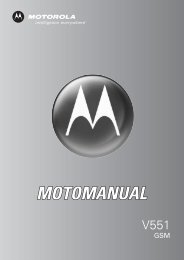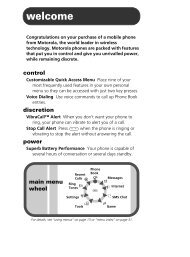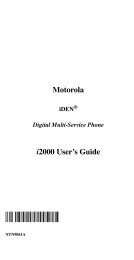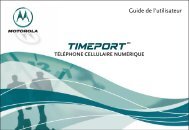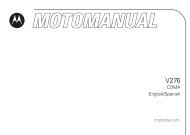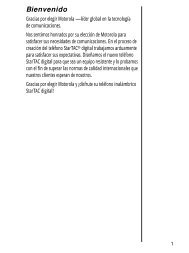Identifying electrical and mechanical design milestones is very ...
Identifying electrical and mechanical design milestones is very ...
Identifying electrical and mechanical design milestones is very ...
You also want an ePaper? Increase the reach of your titles
YUMPU automatically turns print PDFs into web optimized ePapers that Google loves.
concerns. Waiting to perform testing until late in the <strong>design</strong> process or even until final<br />
production build can result in extended product <strong>design</strong> cycle time <strong>and</strong> m<strong>is</strong>sed ship dates.<br />
Releasing Engineering Samples<br />
One example that supports the need for early testing <strong>is</strong> a manufacturer who waits until<br />
engineering samples are produced to begin accelerated life testing (ALT). If during a drop test it<br />
<strong>is</strong> d<strong>is</strong>covered that the product housing cracks in a particular area, the development team would<br />
be forced to re-evaluate the product <strong>design</strong> to find a solution to the cracking <strong>is</strong>sue. At th<strong>is</strong> point,<br />
the manufacturer’s customer would have samples in h<strong>and</strong> <strong>and</strong> the ship acceptance date for the<br />
product would be rapidly approaching. Additional resources <strong>and</strong> an accelerated test schedule<br />
would be required to implement <strong>and</strong> test the various solutions that were proposed. If testing<br />
had been performed earlier in the <strong>design</strong> phase, the <strong>is</strong>sue could have been identified <strong>and</strong><br />
corrected prior to the customer receiving samples. Earlier testing would have also prevented<br />
the cost of expedited testing that was required to validate the product change.<br />
Releasing Final Production<br />
Simply stated, one should never allow oneself to get to th<strong>is</strong> point. The major concern with<br />
releasing final production <strong>is</strong> that a potential field action may be needed to address <strong>is</strong>sues with<br />
product that has already shipped.<br />
Release of Prototype Samples<br />
If a manufacturer waits until prototype level samples are available, unacceptable delays are<br />
likely. Additionally, the delays <strong>and</strong> costs of shipping product Class-9 (M<strong>is</strong>cellaneous Hazardous<br />
Goods) until testing <strong>is</strong> completed will impede the deli<strong>very</strong> of samples to the customer <strong>and</strong><br />
potentially add delays to the development cycle. Having the testing performed at the<br />
establ<strong>is</strong>hment of <strong>mechanical</strong> <strong>design</strong> phase of development can identify necessary <strong>design</strong><br />
modifications that can be addressed with minimal impact on the <strong>design</strong> cycle <strong>and</strong> have little or<br />
no v<strong>is</strong>ibility to the end customer.<br />
Another example involves relatively new testing of lithium products to the st<strong>and</strong>ards in the<br />
“United Nations (UN) Recommendation on the Transport of Dangerous Goods.” Th<strong>is</strong> test <strong>is</strong><br />
required prior to shipping any new power source, such as a battery, that contains lithium. Until<br />
testing <strong>is</strong> complete <strong>and</strong> a Certificate of Conformance <strong>is</strong> <strong>is</strong>sued, all shipments must be sent<br />
Class-9, a <strong>very</strong> expensive shipping class with many restrictions <strong>and</strong> potentially extended<br />
deli<strong>very</strong> times. Because the stress levels of th<strong>is</strong> test program are higher than most product<br />
specifications, the r<strong>is</strong>k of failure <strong>is</strong> also higher. Some common failure modes of th<strong>is</strong> test<br />
program are enclosures opening or cell tabs breaking.<br />
Working with a test <strong>and</strong> measurement facility that underst<strong>and</strong>s how to develop <strong>and</strong> implement<br />
an effective test plan for the specific portable product <strong>design</strong> <strong>is</strong> critical to keeping projects on<br />
budget <strong>and</strong> on time. The facility should staff professionals who create a custom plan that<br />
maximizes early <strong>and</strong> ongoing testing in the <strong>design</strong> process. Testing appropriately at early<br />
<strong>design</strong> stages affords time to make any necessary changes to the product’s <strong>design</strong> without<br />
creating an overly compacted schedule later in the process. The time saved by early testing<br />
can easily translate into cost savings by helping to ensure that the product’s ship date <strong>is</strong> met<br />
<strong>and</strong> overall customer sat<strong>is</strong>faction <strong>is</strong> achieved.<br />
LaW<strong>and</strong>a Quarles <strong>is</strong> a Senior Reliability Engineer at located in Metro Atlanta, Georgia. She has been with Motorola<br />
for 7 years <strong>and</strong> <strong>is</strong> currently responsible for Regulatory Compliance planning <strong>and</strong> implementation. LaW<strong>and</strong>a has a BS<br />
degree in Electrical Engineering from Tuskegee University.




